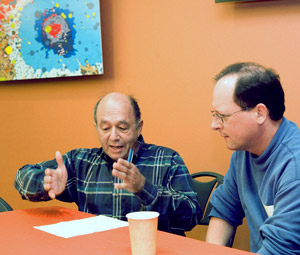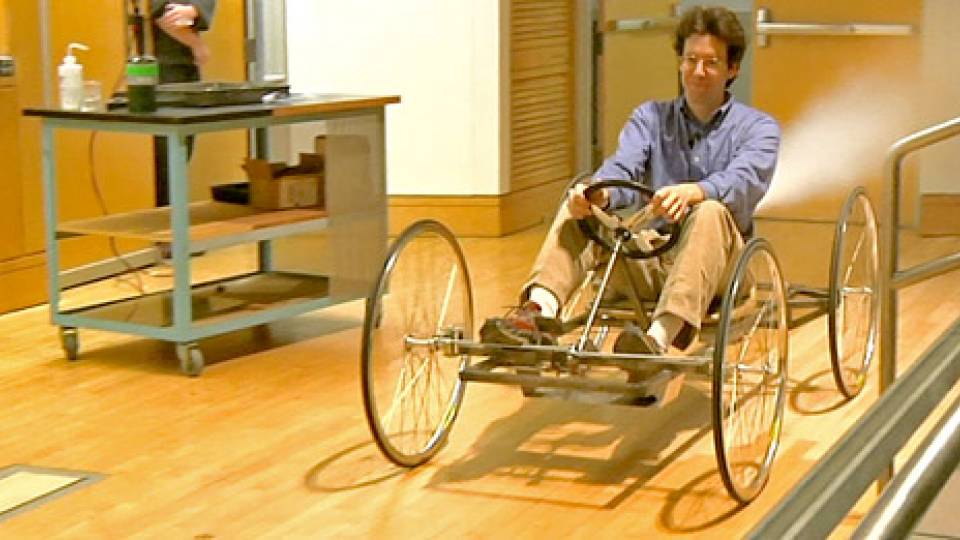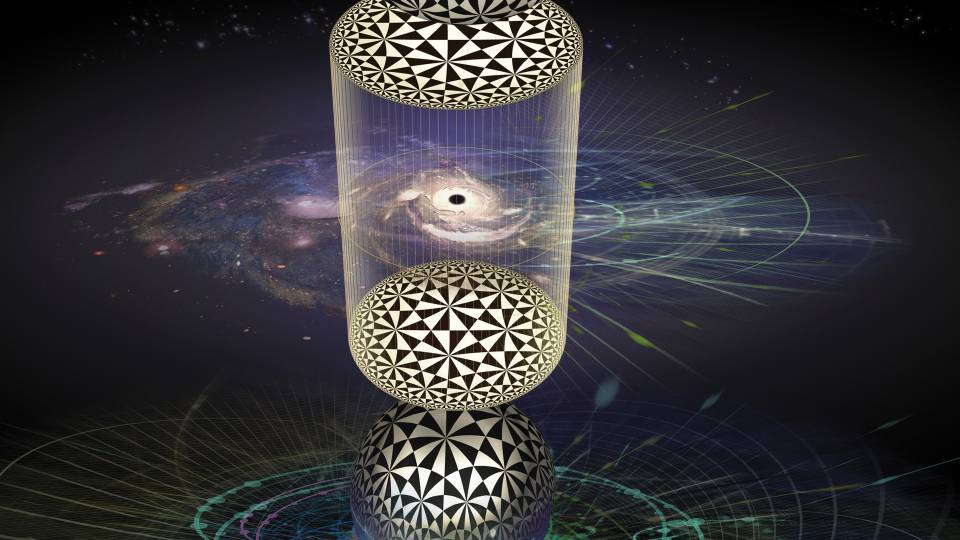A group assembled in a new, modern seminar room in Princeton's Jadwin Hall and waited for the talk to begin.
Silence fell as Lisa Manning, a postdoctoral fellow interested in materials science, stood at the front and explained the mysteries of disordered, noncrystalline solids. These disquieting substances, like sand and mayonnaise, act like liquids at times and solids at others. No one knows why. And when these misbehaving materials are stretched or crushed, no one can yet predict precisely what the resulting contortions will look like.
"In normal solids and liquids, the system is in equilibrium and the thermal temperature tells you about the state of the material, but in glassy solids the system is out of equilibrium," Manning said. "The big mystery, and the goal of my research, is to figure out what variables -- instead of temperature -- describe flow and deformation in these materials."
David Spergel, chair of the Princeton's Department of Astrophysical Sciences, leaned forward and asked about measuring "effective temperature," which might be a useful variable for describing these systems. Spergel often thinks deeply about the twists and turns of matter in the early universe. Aleksandra Walczak, a biophysicist and postdoctoral fellow at Princeton, continued the discussion. She is interested in glass, another perplexing disordered solid, as well as the operations of gene networks.
There were still other questions from more members of the group, among them string theorists, condensed matter physicists, general relativists, materials scientists and researchers interested in the theoretical physics of biological systems. "The fact that disorder never decreases in a closed system is one of the guiding principles in many disciplines, from condensed matter to cosmology, so that concept was familiar to everyone there," Manning said later. "That's what makes this type of interdisciplinary research interesting and fruitful."
The gathering of scientists from so many differing disciplines to hear a common topic is a hallmark of the Princeton Center for Theoretical Science, which staged the event last month. The center, which formally opened its new quarters on the fourth floor of Jadwin Hall in September, serves as a meeting place for scientists of disparate backgrounds. Mathematics and the principles of physics are the common language spoken here. And the willingness to cross the boundaries of various scientific disciplines -- either to find answers that relate to one's own area or to seek out new questions elsewhere -- is the price of admission.
"We want to create a cauldron of brainstorming," said Paul Steinhardt, the Albert Einstein Professor in Science and director of the Princeton Center for Theoretical Science. "We want to bring together our most talented theorists on campus -- faculty, postdocs, graduate students and undergrads -- together with leading scientists worldwide to identify and attack the most exciting problems across the natural sciences."
Indeed, the center, created in 2005, was conceived to allow researchers to think broadly and deeply about subjects. "Princeton is renowned for its historic contributions to theoretical science," said Curtis Callan, founding director of the center and chair of the Department of Physics. "We wanted to find a way to give theoretical science new prominence and to enhance research and education."

Lisa Manning, a postdoctoral fellow investigating complex questions in materials science at the Princeton Center for Theoretical Science, enjoys the interdisciplinary nature of the center.
Beginning in 2004, Callan, Steinhardt and a coterie of faculty members from science and engineering departments campuswide began discussions that would eventually lead to the proposal for the center.
The proposal devised by the group called for a center that would organize workshops, seminars, courses and public lectures that would bring attention to cutting-edge problems in science and promote new directions in research. As part of its mission, the center would attract a corps of center postdoctoral fellows -- outstanding young theorists from around the world who would play a key role in the cross-fertilization of disciplines the center is designed to promote.
University officials approved the idea and provided start-up seed money. They also provided funds for the renovation of most of the fourth floor of Jadwin Hall as center quarters. Generous gifts from donors, mostly anonymous, have ensured that the center will be able to continue its programs and postdoctoral fellowships in the future.
The center operated in temporary quarters on the third floor of Jadwin with limited programs, but opened its new site this fall with its first full contingent of programs and postdoctoral fellows. To celebrate the occasion, the center sponsored a banquet last month drawing theorists from all corners of campus. The event was highlighted by remarks by President Shirley M. Tilghman and a speech by Nobel Prize-winning physicist David Gross on "The Role of Theory in Science."

Frequent center seminars on various topics are meant to draw researchers together and foment spontaneous collaborations. On a coffee break during a session on the Big Bang, Jeremiah Ostriker (left), a Princeton professor of astrophysical sciences, and Paul Bode, a computational astrophysics specialist in the Department of Astrophysical Sciences, hatched an idea on a borrowed piece of looseleaf paper.
Through the center and its various symposia, scientists are allowing themselves to ask big questions. What really happened at the Big Bang? How can we improve our understanding of climate change? Is there a hidden pattern within the complexity of gene networks? Are new kinds of "quantum" computers truly possible? What's the secret to these newly discovered iron high-temperature superconductors? Why do "rare events" like crystallization and chemical reactions occur when they do? And what happens when black holes collide?
Through public lectures and long- and short-term seminars, the center is offering up a wide-ranging intellectual menu.
"Some of the center seminars educated me on fascinating topics, from the behavior of simple organisms to the subtle changes in storm routes; others impacted my research more directly," said Igor Klebanov, a string theorist and professor of physics at Princeton who is also associate director of the center. Informal presentations by center colleagues, he said, helped him learn more about the early universe, a topic that he began researching after joining the center.
Klebanov started working with Antonello Scardicchio, a postdoctoral fellow at the center, after making an impromptu presentation at a lunch meeting on a new string theory paper he had just read. Two weeks later, Klebanov and Scardicchio joined forces with other Princeton researchers to write a paper attacking a remaining problem. The skills that Scardicchio had acquired in research on seemingly unrelated topics, Klebanov noted, turned out to be crucial for this project.
"There is a great deal of unity in theoretical science, and we are making a good use of it here at the center," Klebanov said.
The center, decorated with woodsy tones of cool green, buttery yellows and cherry wood accents, is purposely designed to foster casual conversations and collaboration. The facility, designed by Payette, an architectural firm based in Massachusetts, is light-filled, with frosted glass panels instead of walls enclosing offices. There are conversation nooks, with comfortable chairs, around nearly every corner, each with its own wall-high blackboard.
"What we are trying to foster here is 'incidental science,'" Steinhardt said. "A lot of the best ideas in science come from incidental interactions, where people share ideas. People come here, meet over coffee and an incidental conversation ensues. Suddenly something interesting happens. Some issue emerges and people start collaborating."
Lots of good ideas in science, he said, have come about through such encounters. In his own case, Steinhardt, a physicist who develops theories about multiple dimensions and universes, became interested in quasi-crystals after a conversation with a colleague took an unexpected turn.

Postdoctoral fellows are at the heart of the intellectual ferment at the Princeton Center for Theoretical Science. From left, Thomas Klose, Jean-Luc Lehners, Aleksandra Walczak and Andrei Bernevig enjoy the intellectual freedom the center offers as well as its challenge to think broadly about science.
An investment in the future
In a nod to the central role played by the center's postdoctoral fellows, all of the offices for faculty and postdocs are the same size.
"I don't know anyone my age at any other place who has an office like this," said Andrei Bernevig, a postdoctoral fellow at the center, pointing to his sizable office and huge picture window with a view offering a magnificent tableau of Princeton architecture, including the new Lewis Library.
Each year, the center's faculty fellows conduct an international search, recruiting only three postdoctoral fellows, each for a three-year term. This produces a total of 10 postdocs for the center at any one time. "The idea is to take the best and brightest from around the world and broaden their horizons," Steinhardt said.
To him, the center's postdoctoral program is an investment in research ideas yet to come. "I believe we are developing a new type of postdoctoral fellow better prepared to identify and pursue the most exciting forefronts of science and to set the agenda for future science."
Bernevig, one of the first postdocs recruited to the center, is studying two different topics at once in condensed matter physics -- aspects of the quantum Hall effect and iron high-temperature superconductors. "The kind of intellectual freedom the center allows you is remarkable," said Bernevig, who joined the center in 2006 and will remain until 2009, when he will join the University as an assistant professor. "If you want to work in seven fields simultaneously you can do that," he said. "Or you can work in one field."
Aleksandra Walczak, who joined the center as a postdoctoral fellow in 2007, enjoys the broad array of programs. A biophysicist, she is interested in systems with many different interacting parts. She has zeroed in on the interconnections between proteins for her analysis. "A lot of the concepts of physics are similar, just dressed in different guises," she said. "A broad perspective is good for everyone."
For Jean-Luc Lehners, another postdoctoral fellow, being based at the center has helped him broaden his conversations. "People are thinking about all sorts of problems in physics here," said Lehners, who is interested in cosmology, string theory and supergravity.
Before he joined the center in 2007, he said, he was much more narrowly focused. Now, he is regularly called upon to speak to scientists working in other areas. It compels him to explain his work clearly and succinctly. "It forces me to think about what is most important -- about the new ideas, which is very good," he said. "If you are too focused, you can get sidetracked in the details and get stuck there."
The smorgasbord of ideas offered at the center is equally appealing to the center's faculty fellows, who work at the center but maintain their departmental connections.
"I've always been interested in learning new things, and I'm not satisfied in just staying within one particular field," said Salvatore Torquato, whose home department is chemistry but who is an associated faculty member in a range of programs and departments, including applied and computational mathematics, chemical engineering, mechanical and aerospace engineering, and physics.
Such interdisciplinary endeavors may not be for everyone, he said. "You need accomplished scientists who are willing to cross boundaries and learn a new language," he said. "That takes a unique bunch of people."
Torquato especially enjoys the center's weekly "brownbag" lunches in which someone -- either one of the eight faculty fellows, a visiting fellow or a postdoc -- stands before one of the center's ubiquitous blackboards and speaks about his or her work. "Most of the people in the room don't know what the expert is going to speak about," Torquato said. "The whole purpose is to really understand and to dig deep and ask basic questions. You end up learning a lot about other fields."





